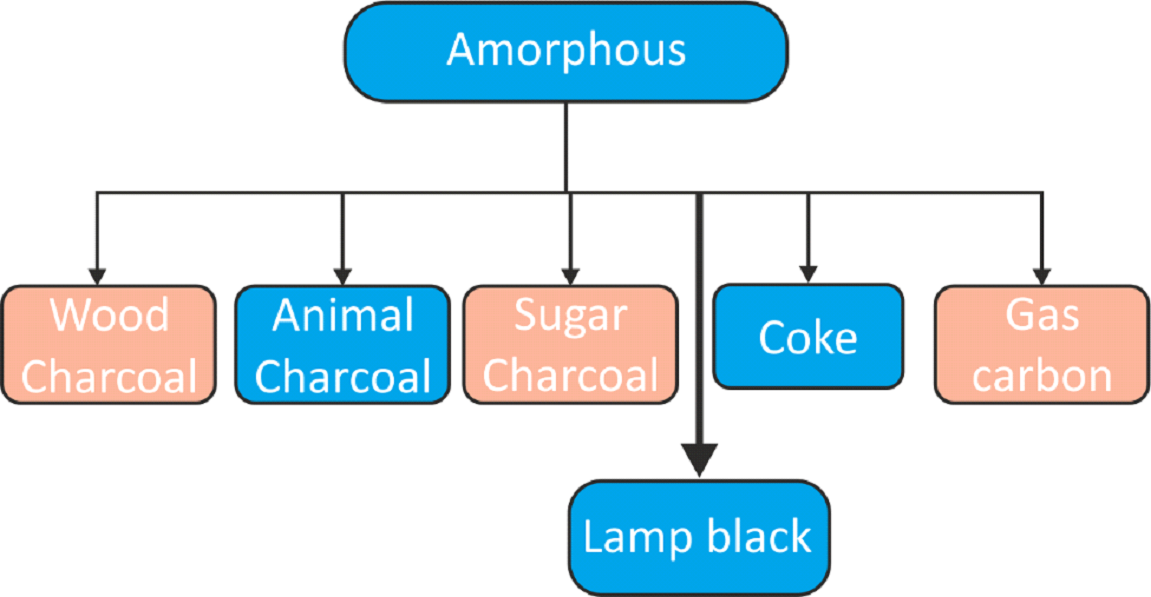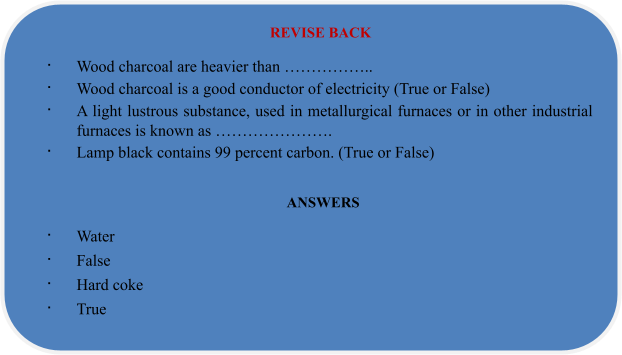
Amorphous forms of carbon
Carbon and its compound of Class 8
AMORPHOUS FORMS OF CARBON definition
Carbon shows allotropism due to the catenation property and pi-pi bond formation. It exists in two allotropic forms that are crystalline and amorphous forms. An amorphous form of carbon is free and reactive having localised pi-electrons. The amorphous forms of carbon involves coal, charcoal and lamp-black. These forms are obtained, in small quantities when wood, bones, kerosene oil etc. are heated in the absence of air.

Charcoal:
Charcoal can be obtained from a variety of sources. It is produced by heating a source material in the absence of air. Such a process is called destructive distillation. Charcoal is normally named after the source from which it is obtained.
Charcoal is classified into three types based on its source material -
1. Wood charcoal: It is derived from wood by heating it in the absence of air. This process is called destructive distillation of wood. In this process a dark coloured liquid is obtained. It is wood tar and, the clear liquid formed above the dark liquid, is known as pyroligneous acid. It turns blue litmus red. A black mass is also obtained. It is called wood charcoal, i.e. the residue of sawdust.
Properties of wood charcoal: The properties of wood charcoal are as follows
- It is a black, porous and brittle solid.
- It is heavier than water (specific gravity 1.5)
- It floats on water as it has the capacity to hold air in its pores.
- It is a good adsorbent.
- It is a bad conductor of electricity.
Uses of wo od charcoal:
The uses of wood charcoal are as follows
- It is used as a fuel.
- It is an important constituent of gunpowder.
- It is used in gas masks or respirators as it adsorbs harmful gases.
- It forms a component of cigarette filters as it adsorbs the poisonous vapours of nicotine.
- It helps in decolorising sugar syrup, and refining oils and fats by removing coloured impurities.
- It is used as a disinfectant.
2. Animal charcoal: It is also known as bone charcoal. This type of charcoal is obtained by the destructive distillation of bones in the absence of air. Bone oil and pyridine are obtained as by products.The chief ingredient of anima! charcoal is calcium phosphate with the carbon content limited to 10-i2 per cent only.
Properties and uses of animal charcoal: Animal charcoal has the following properties and uses -
- It has the property of extracting coloured materials from solutions.
- It is easily wetted by liquids and is extensively used to decolorise sugar solutions.
- It is used in the manufacture of phosphorus and its compounds.
3. Sugar charcoal: Sugar charcoal is the purest from of amorphous carbon. It is prepared by heating cane sugar or glucose in the absence of air.


It can also be prepared by the dehydration of cane sugar or glucose in the presence of concentrated sulphuric acid. The acid absorbs the water to leave behind carbon.
Related Topics
Coal:
Coal is mixture of compounds of carbon, hydrogen, oxygen and some free carbon. The black material of vegetable origin formed by carbonisation, under the surface of earth is called coal.
Carbonisation:
The process of removal of hydrogen and oxygen form the wood by the bacterial action in the absence of air, deep under the surface of earth is known as carbonisation.
Formation of Coal:
Coal was formed in prehistoric times (200 million years to 250 million years) when huge forest areas got buried under the surface of earth and due to humid and hot conditions and were attacked by bacteria, which progressively removed hydrogen and oxygen leaving behind carbon. Due to the extreme pressure of earth, the carbon got compact to form stony residue called coal. Some amount of hydrogen also got converted into methane which was trapped along with the coal.
The approximate percentage of carbon present in different varieties of coal is –
Type of coal Percentage of carbon
Peat 60%
Lignite (soft coal) 67%
Bituminous (household coal) 88%
Anthracite (hard coal) 96%
Peat is the most inferior and anthracite is the most superior quality of coal. Coal is mainly used as fuel and to make coke. Coke is the purest form of coal. Coal is also used as a source of large number of organic compounds. These organic compounds are used in the manufacture of drugs, explosives etc.
Uses of Coal
- It is used as a fuel in big factories and thermal power stations.
- On destructive distillation, it yields products like coke, coal tar, ammonia liquor and coal gas which are put to domestic and industrial uses.
Coke
Preparation
When coal (bituminous) is subjected to destructive distillation at 1300°C, a mixture of liquids and gases escapes, which is separated into the following products:
- Gaseous products, i.e., coal gas
- Liquid product, i.e., ammoniacal liquor (forms upper layer), coal tar (lower layer), etc.,
- A solid residue called coke (85% carbon) is obtained.
Coke is of two types, hard coke and soft coke.
(i) Hard coke : It is a light lustrous substance, used in metallurgical furnaces or in other industrial furnaces.
(ii) Soft Coke : It is a black and porous substance, which ignites with difficulty and is used in household furnaces.
Uses of coke
- As a smokeless fuel.
- As a reducing agent for producing iron and steel.
- In the manufacture of water gas (CO + H 2 ), producer gas (CO + N 2 ) and artificial graphite.
Lamp Black:
Lamp black contains 99 percent carbon. It is prepared by heating carbon rich substances like petroleum, kerosene, turpentine oil etc., in a limited supply of air. The soot is collected over damp blankets in chambers and is obtained from them by jerking.
Uses of lamp black:
- Lamp black is used in making black printing ink.
- It is used as a filler in tyres to increase their durability.
- It is used in shoe polish and kajal.
NOTE: Kajal is prepared by holding an inverted clean plate over a burning 'diya' using mustard oil as fuel. The black mass that gets deposited on the surf ace of plate is kajal










